|
|
Canku Ota |
|
|
(Many Paths) |
||
|
An Online Newsletter Celebrating Native America |
||
|
December 29, 2001 - Issue 52 |
||
|
|
||
|
The Frog and the Antelope |
||
|
Kootenai Legend
|
||
|
|
|
Antelope was chief there. He was the fastest runner. His medicine was strong. No person could beat him at running. Many had tried. All gave it up. Antelope was the fastest runner! There was another village on Tobacco Plains. Frog was chief there. He could not run fast. But he was a smart man. One day when his people were playing games he said to them, "Listen! The antelope is faster than I am. But I am smarter than he is. I will prove this to you. Stay where you are until I come back." He hopped along the trail that led to the antelope village. When he found the chief's lodge he went inside. They smoked the pipe there, and then the antelope chief began to brag about his running. "No person can beat me," he said. "I can just trot along and beat most persons."
"But you cannot run -- ha-ha-ha!" laughed the antelope, taking a long draw on the pipe. "Oh, I don't know about that. I am not so slow at running, and I am a fast thinker," said the frog chief. "Of course you would not say that you would race with me, though," smiled the antelope, handing back the pipe. "I might," said the frog chief slowly. "What is that?" asked the antelope. "You might? "Yes." "When?" "Tomorrow." "Where?" "Here, along the trail between our villages. I cannot run well where the ground is rough, you know. I must have a smooth place." "Ha-ha-ha!" laughed the antelope. "How far shall we run?" "From your village to mine and back again," answered the frog seriously. "All right," agreed the antelope. "I suppose I shall be laughed at for racing with you. But I will race just the same. A person must use his power or he will lose it."
"Bet? Why, anything -- everything I have. What have you got to bet?" "Well, not much," sighed the frog chief. "But you will admit that our clothes are pretty. I will bet my clothes, and all my tribe will do the same. How will that suit you?" "Fine!" smiled the antelope. "I like nice clothes." The frog's clothes were green and beautiful. Besides, they were always cool in summer. "Fine! Be here at sunrise," smiled the antelope, thinking of all the nice clothes that would be his after the race. "I will be here," promised the frog chief, "and I will bring the whole tribe. Ho!" Then he went out, and down the trail to his village, hopping, hopping, hopping, and thinking, thinking, thinking, till he got home to his lodge. When he was gone the antelope made his people a speech. He told them to go to a side-hill at sunrise to watch the race. "When it is finished," he said, "I shall have more clothes than I need. I will divide them among you, and you know that the frog-persons' clothes are fine in summer. I suppose I shall be laughed at for racing this person," he added, smiling, "but think of the pretty clothes we shall have, to pay for the laughing. Be on the hillside at sunrise. I have spoken." Then he went back to his lodge to laugh. The frog chief did not make a speech to his tribe. He just went quietly into his lodge and kept thinking and smoking and thinking till morning was near. Then he went outside and called his people. "Follow me!" he said, and began hopping up the trail toward the antelope's village. All his people were behind him, hopping, hopping, hopping along, wondering and wondering and wondering what was going on in their chief's head. But nobody asked him. They just hopped along, each one tending to his own business of hopping until they were all there. The sun was not yet up, and the air was fine and clear. "Now listen to me, all of you," said the frog chief, looking back along the trail that was green with frog-persons. "I am going to run a race with the antelope chief this morning at sunrise. I have bet all my clothes and yours on it. If I lose this race we shall have bad times. That is all." The frogs laid their hand upon their mouths, for they were astonished. "There must be no mistakes made here this morning," went on the frog chief sternly. "Pay attention to me!" "First frog, turn around! No, you hop one long hop down this trail. That is it. Now hide yourself and stay still. Second frog, turn around! Now you hop one long hop past the first frog. That is it! Now hide yourself, and stay still. Third frog, turn around! Now you hope one long hop past the second frog. That is it! Now hide yourself, and stay still." He made enough frogs turn around and hop one long hop past the last one until they reached to his village along the trail. And when the last one hopped into his place near their village, not one of them could be seen. But there were frogs all the was from the antelope's village to the frog's village. Andy they were just one long hop apart. "Now you trail-frogs, listen!" said the frog chief. "You are all in this race, every one of you, and there must be no mistakes made if you want to save your clothes. When we start this race, I will hop one long hop down the trail, then number one will hope one long hop down the trail, then number two, and number three, and number four, and so on clear to our own village, each one stopping right where he lands after hopping one long hop. But the hopper must hop just ahead of this fast antelope-person. Understand what I am doing? I am cheating him. We all look alike! He will think the last hopper down there by our village is me."
Nobody said a word. "All right," said the frog chief. "The rest of you come along with me." "Good morning," bowed the antelope, stretching himself, and looking toward the east, where the sun was coming. "Good morning. You have brought many people with you," he smiled. "Yes, quite a few. More than you realize, I think. We are not very tall, you know," answered the frog chief. "Are you ready?" asked the antelope, bounding about to show off. "Yes, I am all ready," said the frog chief, and the sun is rising, too." "All right, then." The antelope chief whistled, and out of their lodges came all his people. They ran up on the hillside and stood still to watch the race.
"Well! He is faster than I thought," said the antelope, beginning to run. Still the frog was a little ahead of him -- always a little ahead. "Well! This person is not so slow." he thought, and began to go like the wind. But always the frog-person was a little ahead of him -- one long hop ahead. He began to think of his property now. Oh, ho! The frog-person was a little ahead when finally he reached the frog village, and turned to race back. "I will beat him now," he thought. "This way is uphill." He ran as fast as he could go, pounding the trail with his hoofs, But, as before, always the frog-person hopped a little ahead of him, till, out of breath, he fell down near his own lodge -- beaten! Oh, ho! Now everybody began to laugh. They laughed very hard, and while they were laughing, the frog chief hopped near the antelope, whose sides were panting so fast he could not speak. Oh, ho! "A little running seems to tire you," smiled the frog chief, looking around at all the property he had won in the race. His sides were not panting. He had only hopped two long hops -- one down the trail and one up again. "I guess you a short-of-breath-person," he added, sitting down.
"Oh, I am not so very fast at running, replied the frog chief, beginning to gather up the antelope's property, "but I spend a good deal of time thinking. I am a pretty fast thinker, you will find." Ho! Print and Color Your Own Pronghorn
Antelope |
|
|
|
Pronghorn Antelope
(Antilocapra americana)
|
|||
|
The Pronghorn is the only animal in the world with branched horns (not antlers) and the only animal in the world to shed its horns, as if they were antlers. The Pronghorn, like sheep and goats, has a gall bladder, and like giraffes, lacks dewclaws. If that weren't enough, the Pronghorn is the fastest animal in the western hemisphere, running in 20-foot bounds at up to 60 miles per hour. Unlike the Cheetah, speedburner of the African plains, the Pronghorn can run for hours at quite a fast pace. The fleet-footed, large-eyed pronghorn is an animal of the plains. Adapted for speed and for seeing long distances, it inhabits areas where both its sight and its running will be unimpaired by woodland vegetation. Water in the immediate vicinity is not a requisite because the pronghorn is so adapted physiologically that it can go for long periods without drinking. Apparently, it has the ability to conserve body water and to produce metabolic water. Antilocapra Americana occurs from southern Alberta and southern Saskatchewan, Canada through the western United States to Hidalgo, Baja California, and western Sonora, Mexico. Pronghorns are graceful, strikingly colored
deer- or antelope-like animals with stocky bodies and long, thin legs.
They are a bit smaller than white-tailed deer, adult males (bucks) commonly
weighing from about 100 to 130 pounds, females (does) 75 to 100. The primary color ranges from brown to reddish-brown to light tan, offset by a white rump and belly and two white stripes on the throat. A short dark mane grows along the neck, and males also sport a black mask and black patches on the sides of the neck. Pronghorn bucks sport black, erect horns that average about twelve inches in length (but may reach eighteen inches) and are tilted to the side, reaching past the tips of their ears. They are remarkable for the prongs, or branches, that give the animal its common name. The horns resemble giant, backward curving hooks with coat hangers on the front. (They somehow remind me of can openers!) Most females also sport horns. On average, they are less than half as long as those borne by males, rarely longer than their ears, and are rarely pronged. As in antelopes, goats, sheep, and cattle, the horns consist of a bony core covered by an outer sheath. However, pronghorns are the only mammals that shed their sheaths. Well, sort of. Actually, there are other mammals that shed their sheaths in fragments; pronghorns shed theirs whole. Males shed their horns each fall after the
breeding season and grow back new ones by the following summer. Females
shed their horns irregularly Sometimes, pronghorns are their own worst enemies. William Clark, of the Lewis and Clark expedition, reported, “antelopes are curious and will approach any thing which appears in motion.” The famous naturalist John James Audubon later tested Clark’s observation, lying on his back and kicking his feet in the air in sight of a band of pronghorns. One of the animals approached to within about sixty yards! Early hunters resorted to such antics to lure pronghorns within range of their guns. But pronghorns aren't stupid. While living in the North Dakota Badlands in the 1880s, Theodore Roosevelt noted that few pronghorns would fall for that trick. Another peculiar trait is their disinclination
to jump over fences or other objects. A low brush fence no more than
a meter high will ordinarily turn the animals, and it is not uncommon
for small bands to be reduced almost to the point of starvation within
a fenced enclosure while plenty of food is available on the outside.
They can jump over moderately high obstructions, however, when hardpressed.
Ordinarily, they crawl under or between the wires of barbed-wire fences. Pronghorns have a particular fondness for flowers and fruits. The flowers of cutleaf daisy, white daisy, stickleaf, paper flower, and woolly senecio are consumed in large amounts. What animals eat pronghorns? Before the West was tamed, packs of wolves cooperated in chasing down pronghorns. Now that wolves have been wiped out over most of the pronghorn’s range, the coyote is their most important predator. Bobcats are important predators in some areas. Golden eagles are reported to prey on fawns in areas close to bluffs.
In late summer and early fall, bucks engage in mock battles. A lone buck may even challenge an imaginary rival. In northern pronghorn country, females begin paying more attention in September and October, when bucks may gather harems of as many as fifteen does in their territories. (Pronghorns are polygamous. In other words, a male may mate with several females.) Pronghorns may begin breeding in July or August farther south. Pronghorn gestation (or pregnancy) lasts about 250 days, and the young are born in May or June. The first birth usually produces a single young. In later years, does usually bear twins. A newborn pronghorn, or fawn, weighs from about five to nine pounds and sports a gray coat until it’s about three months old. Newborns are odorless and lie motionless for hours while their mothers are away grazing. The mothers return to nurse their young three or four times a day. Pronghorns once roamed North America by the
millions. They may have even been more abundant than the bison. Clark compared the animal to a sheep and antelope, but called it a “goat.” Meriwether Lewis called it an “antelope,” the name that stuck. Explorers and settlers who followed in the explorers' footprints killed pronghorns for meat and sport. Pronghorns were displaced by cattle, fields, fences, and roads. By 1908, less than 20,000 remained. Fortunately, the pronghorn received protection just in time. Pronghorns found refuge in early national parks and wildlife refuges.
|
|||
|
|
||
|
|
||
| Canku Ota is a free Newsletter celebrating Native America, its traditions and accomplishments . We do not provide subscriber or visitor names to anyone. Some articles presented in Canku Ota may contain copyright material. We have received appropriate permissions for republishing any articles. Material appearing here is distributed without profit or monetary gain to those who have expressed an interest. This is in accordance with Title 17 U.S.C. section 107. | ||
|
Canku Ota is a copyright © 2000, 2001, 2002 of Vicki Lockard and Paul Barry. |
||
 |
 |
|
|
The "Canku Ota - A Newsletter Celebrating Native America" web site and its design is the |
||
|
Copyright © 1999, 2000, 2001, 2002 of Paul C. Barry. |
||
|
All Rights Reserved. |
||
 There
was a village on Tobacco Plains.
There
was a village on Tobacco Plains.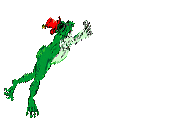 "I
like racing, myself," said the frog chief, passing the pipe to
Antelope. "All my people like racing."
"I
like racing, myself," said the frog chief, passing the pipe to
Antelope. "All my people like racing." 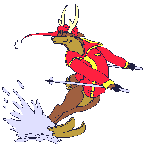 "Yes,"
said the frog chief, scratching his nose. "I am sure you will be
laughed at, all right. Now, what will you bet on our race?"
"Yes,"
said the frog chief, scratching his nose. "I am sure you will be
laughed at, all right. Now, what will you bet on our race?" 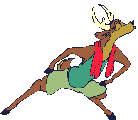 "Here
we go," laughed the antelope chief, trotting down the trail. But
the frog-person was always a little ahead of him.
"Here
we go," laughed the antelope chief, trotting down the trail. But
the frog-person was always a little ahead of him.  "Well,
you have beaten me, and I admit it," panted the antelope chief.
"You are a very fast runner. That is all I can say. I misjudged
you. But I know now."
"Well,
you have beaten me, and I admit it," panted the antelope chief.
"You are a very fast runner. That is all I can say. I misjudged
you. But I know now." 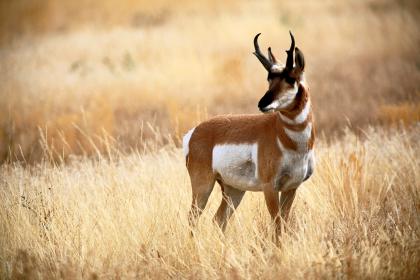 Entirely
unique on this planet, the Pronghorn's scientific name, Antilocapra
Americana, means "American antelope goat." But the deer-like
Pronghorn is neither antelope nor goat -- it is the sole surviving member
of an ancient family dating back 20 million years.
Entirely
unique on this planet, the Pronghorn's scientific name, Antilocapra
Americana, means "American antelope goat." But the deer-like
Pronghorn is neither antelope nor goat -- it is the sole surviving member
of an ancient family dating back 20 million years. A
long, woolly undercoat is covered by coarse, brittle hairs. The hairs
can be erected at will, aiding pronghorns in adjusting to both heat
and cold. Individual hairs are loosely attached. This results in the
continuous shedding that makes pronghorn skins nearly worthless as rugs.
A
long, woolly undercoat is covered by coarse, brittle hairs. The hairs
can be erected at will, aiding pronghorns in adjusting to both heat
and cold. Individual hairs are loosely attached. This results in the
continuous shedding that makes pronghorn skins nearly worthless as rugs. An
interesting trait of pronghorns is their highly developed sense of curiosity.
They insist on examining at close range any unrecognized object, particularly
one that is in motion. Because of this, it is possible for man to lure
the animals within close range by hiding behind a bush and waving a
handkerchief or other object slowly back and forth. Indians, and sometimes
our present-day hunters, have utilized this ruse in bagging them.
An
interesting trait of pronghorns is their highly developed sense of curiosity.
They insist on examining at close range any unrecognized object, particularly
one that is in motion. Because of this, it is possible for man to lure
the animals within close range by hiding behind a bush and waving a
handkerchief or other object slowly back and forth. Indians, and sometimes
our present-day hunters, have utilized this ruse in bagging them.  Pronghorn
does (females) usually first breed at an age of 16 to 17 months, bucks
(males) at about three years. In spring and summer, breeding-age males
stake out territories, which they defend from other males. Females travel
freely between these territories.
Pronghorn
does (females) usually first breed at an age of 16 to 17 months, bucks
(males) at about three years. In spring and summer, breeding-age males
stake out territories, which they defend from other males. Females travel
freely between these territories.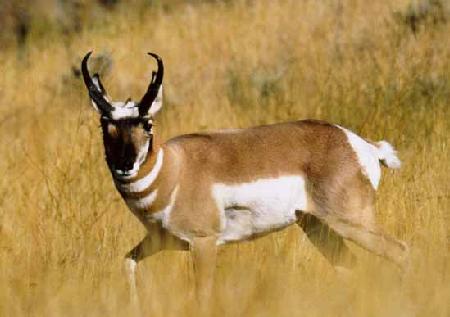 Pronghorns
were seen by members of Coronado's Spanish expedition into the Southwest.
But nearly three centuries passed before Lewis and Clark officially
discovered and described the species. William Clark shot the first one
on September 14, 1804, near the mouth of Ball Creek in present Lyman
County, South Dakota. (They had earlier seen pronghorns not far away,
below the mouth of the Niobrara River.)
Pronghorns
were seen by members of Coronado's Spanish expedition into the Southwest.
But nearly three centuries passed before Lewis and Clark officially
discovered and described the species. William Clark shot the first one
on September 14, 1804, near the mouth of Ball Creek in present Lyman
County, South Dakota. (They had earlier seen pronghorns not far away,
below the mouth of the Niobrara River.)